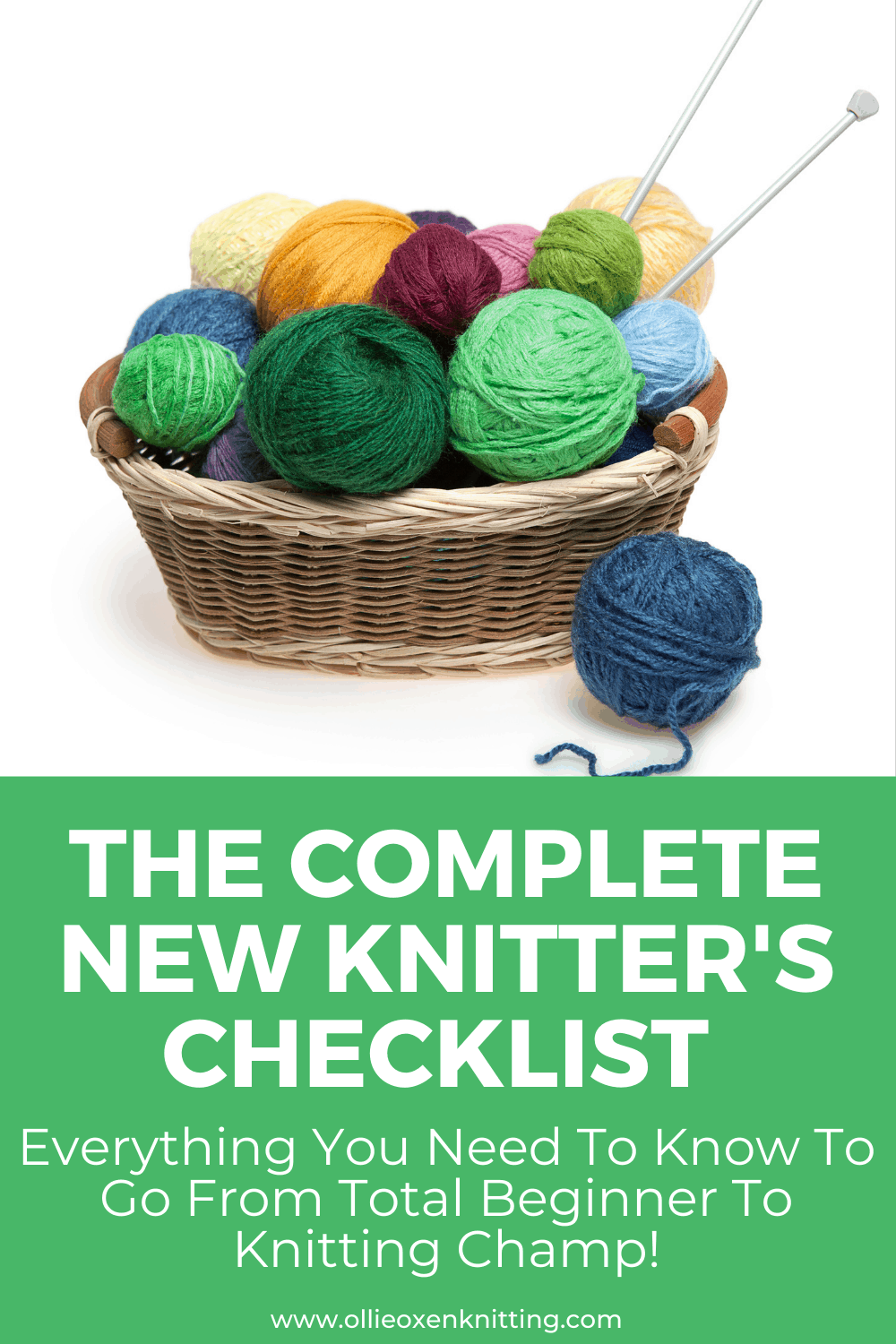So you’re new to knitting? Congratulations! It’s so stinkin’ fun to start something new, especially when it’s a craft as timeless and expansive as knitting. If you’re a bit overwhelmed with all of the options, don’t worry! This list will get you from beginner to intermediate in a jiffy. Whether you’ve been knitting for five minutes or five years, this list will make sure you’ve got the basics down pat.
Super Duper Basic Knitting Essentials
Wanna know something really neat? You don’t need to know almost anything to start knitting! If you can learn the following five things, you know all you need to know to call yourself a knitter. Let’s hop to it!
Know Your Yarn Tail From Your Ball End
When you’re first casting on, there will be two ends of yarn: the yarn tail and the ball end. It’s important to know which is which since it does matter for cast ons. After you’ve knit a few rows, this will be pretty straightforward since your yarn end will be on the cast on row and your ball end will be the yarn you’re working with.
Know How To Cast On
Ah, the humble cast on. It’s the start of every project and the foundation for a great finished project. When learning to knit, most knitters learn the Long Tailed Cast On. It’s a great classic that is pretty and versatile. Once you’ve gotten your feet wet, there are tons of different cast ons to play with for every type of project.
The Knit Stitch
Knitting just wouldn’t be complete without the knit stitch! Once you know how to make this stitch, you’re well on your way to being an established knitter. I’m going to let you in on a little secret: most of the fancy knitting stuff you’ve seen is just a variation of the knit stitch. There! I’ve said it. Now you know know that if you can just knit, you can easily tweak it to do just about anything.
The Purl Stitch
While you could technically make a bunch of stuff without it, learning the purl stitch is the quickest way to expand your knitting options. What’s neat about a purl stitch is that it’s actually just the backside of a knit stitch. So when you’re purling, you’re creating a knit stitch just facing a different direction. Pretty neat, hu?
Be Able To Cast Off
After you’re done knitting, you need to find a way to finish the project. That’s where casting off (also called binding off) comes in. There are multiple bind off techniques to match all kinds of projects, but you only really need to know one to get started.
Weave In Ends
After you’ve cast off, it’s time to get rid of the ends. Every project you ever knit will have a minimum of two ends to weave in so go ahead and get real comfy with it! Personally, I find it relaxing. Either way, as soon as you weave in your ends, your project will be official knit!
More Beginner Knitting Skills
Just to be crystal clear, the only skills you really need to get started knitting are the ones above. These skills will all dramatically improve your knitting but I don’t want you seeing this long list and thinking that it’s all mandatory before you get to enjoy knitting! These skills will definitely enhance your knitting career so go ahead and dive in with whatever catches your eye.
Know The Difference Between A Yarn Ball, Cake, Skein, And Hank
When you go peruse a yarn shop, you’ll likely see a little bit of all four of these. While they’re all used to keep your yarn tangle free, each of them has it’s own benefits. If you really want to rack up some brownie points, you can learn how to convert your yarn into all four of these arrangements. At the bare minimum, it’s important that you know how to convert a hank into something else so you can knit with it without creating a tangled mess!
Know How to Read a Yarn Label (And Know What the Terms Mean)
That little piece of paper that comes wrapped around your yarn is chocked full of helpful information. While some of it may sound cryptic at first, it’s all fairly straightforward once you familiarize yourself with the terms. Knowing what the label says is an easy way to make more informed decisions about your next project. Picking a great yarn is, in my opinion, the fastest way to having a great finished project!
Know How to Read a Knitting Pattern and Abbreviations
Learning how to read a pattern and to decode abbreviations is straight up essential if you want to, ya know, use a pattern. This is an easy and quick way to open up opportunities. There are literally thousands of knitting patterns available so learning how to read a pattern is a pretty worthwhile venture.
Know How to Read a Knitting Chart and Their Symbols
Where all my lace knitters at? While charts are used for patterns beyond lace, they’re super common in lace patterns. If you’re a visual learner, charts are a nifty way of “reading” a pattern at a glance. I especially love that knitting charts make it easier to read your knitting and to catch mistakes before they happen.
Be Able to Correct Common Knit Mistakes
Once you’ve spotted a mistake, knowing how to fix it is kind of important! Sometimes ripping back your knitting is the best course of action but for many things, just a quick tweak is all you need. Dropped stitches, holes, twisted stitches, and split stitches are a good place to start.
Know How to Read Your Knitting (And Be Able to Identify a Mistake)
Speaking of mistakes, learning how to read your knitting makes catching mistakes a breeze. Learning how to read your knitting is what will give you the ability to leave your pattern at home, create your own patterns, and just all around wing it. By being able to tell what is going wrong (or right) with your knitting, you can correct things long before they become a problem.
Know The Difference Between English and Continental Knitting
The two main ways of knitting are called English and Continental. When you learned how to knit, you likely learned the English method but, regardless of what method you were taught, it’s so helpful to be able to do both. Colorwork becomes so much more fun and quick when you can hold one yarn Continental style and one English! But even if that’s not your cup of tea, if you get into knitting a TON, I always think it’s a good idea to have a mini project in the other style to prevent hand injuries. You can’t knit “all the things” if you pull something!
Know The Needle Types and Materials
Eventually, you’ll be ready to knit with a different set of needles. But what material? And what kind for what project? And what if you don’t have the dough to buy all the ones you want? All great questions, my friend. Picking a good set of needles for your project can totally change the name of the game so it really helps to read up on it.
Know About Yarn Weight
After you’ve knit a bit, it’s time to start exploring the wonderful world of yarn! Yarn has many characteristics but one of the main ones that you need to know is the yarn weight and how to pick the correct yarn weight for your next knitting project. Yarn weight will help you determine the thickness, sturdiness, and overall feel of your final fabric.
Know About Yarn Content
Yarn content is, just that, the content that makes up your yarn. There are tons of options out there. While the most common are wool and cotton, that’s just the tip of the iceberg. Picking the ideal yarn content for your knitting project is a skill but it’s oh so much fun. With so many incredible yarns out there, it’s no wonder that so many knitters have a big stash!
Picking Yarn Colors
One of the most wonderful parts of playing with yarn is getting to mix and match all of the colors! There’s something for everyone but not every color or style will match every project. You may love the self striping tonal yarn but does it love the lace project you have your eye on? How about that burgundy tweed yarn and those cables you’ve been dying to try? Learning how to pick the right color and style for your project can take it from “meh” to “Wow!” with a simple yarn swap.
Learn How to Mix Knits and Purls
Once you know how to knit and purl, there are lots of things you can create with just knits and purls to make different fabrics. Stitches like garter, stockinette, and ribbing are just the beginning!
Increase And Decrease Stitches
If you want to get involved with any kind of shaped project, you’ll want to learn a few increases and decreases.
Adding New Yarn To A Project
Inevitably, you will run out of yarn during a project and will need to join the yarn from your next ball. There are a handful of methods that can make your join beautiful and seamless.
Slip Stitches
Slip stitches are a fun way to add texture and variation to a project. They’re quick and easy to do but, depending on how you arrange them, can have a large visual impact.
Tinking / Unknitting / Frogging / Ripping
No matter what you want to call it, learning how to undo your work is important for fixing mistakes. This can be done with just one stitch or you can undo your entire work. This pairs well with using a lifeline (common in lace knitting) or with completely undoing a project to use the yarn on something else.
Washing and Blocking
Washing and blocking is where magic meets knitting. While you obviously will need to wash your knits from time to time, blocking is what will take your project from “homemade” to “handmade”. It’s especially powerful for lace knitting but it’s worth learning for just about any project.
Where To Go From Here
Once you’ve got a handle on all of this stuff, what do you do next? Well that depends on what you want to try! The wide world of knitting has so many possible avenues. It’s truly a craft where you’ll never truly “be done”. I love that there is always something new to try!
What About You?
What skills are you going to tackle next? Let us know in the comment section down below!












